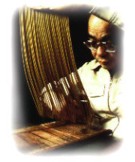|
 Incense was first brought to Japan in the 6th Century by Buddhist monks. The delicate scents of koh (the Japanaese word for incense) had their origin in secret recipes passed down through the ages. Indeed, some of the scents offered today are hundreds of years old. Incense was first brought to Japan in the 6th Century by Buddhist monks. The delicate scents of koh (the Japanaese word for incense) had their origin in secret recipes passed down through the ages. Indeed, some of the scents offered today are hundreds of years old.
Ingredients for traditional Japanese incense originate from various countries; for example, aloeswood originates from Vietnam and Borneo, sandalwood comes from India, and cassia is from China.
The work begins with the inspection of the ingredients; because they are elements from nature, understanding the quality and the characteristics of the ingredients is essential. Then there is the blending process, which requires an enormous amount of skill. When blending with natural ingredients, the quality, balance and ratios of each element are critical. The slightest variation in amount or quality of any component can dramatically change the resulting fragrance. The amount of moisture, along with drying-time and production methods, can also strongly influence the scent. Master blenders consider the process to be an artistic endeavor rather than mere "production".
The density of a single stick of incense matters significantly. Fineness or coarseness of ground ingredients affect its burning temperature. Natural incense needs to breathe. If it is too dense, it burns at a lower temperature which changes the scent. On the other hand, if it is too loose, it burns at a higher temperature and the fragrance may be diminished.
Nearly 400 sticks are laid down on a flat board and cut with a bamboo knife while they are still soft.
As it is made with such care and contains the finest natural ingredients, Japanese incense matures and improves with time, like fine wine. The scent becomes deeper and more mellow, reflecting subtlety and refinement. Held together without a wooden or bamboo core (as is the case with most incense from other countries) these incense deliver the pure essence of the ingredients.
|